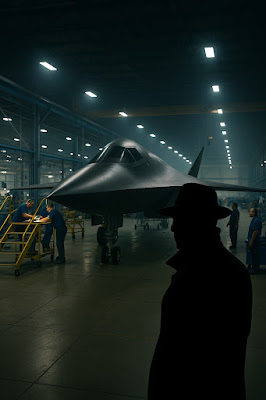 |
| A Russian mole watches from the shadows as America’s next-generation spy plane is built—because one stolen secret could shift the balance of power. |
Riding
high above seventy thousand feet, where the air’s razor thin and the sky blurs
into space, there’s a new bird in the air—and it’s not one you’ve seen before.
It’s not some drone on autopilot. It’s not a satellite snapping long-range
shots from orbit. This thing’s different. Sharper. Quieter. Deadlier. And it’s got real people in the
cockpit—operators with the guts and instincts to make snap calls a machine
wouldn’t even know needed making.
This is America’s next-generation spy
plane, and while the rest of the world’s still guessing the rules, it’s already
rewriting the playbook. It’s the same kind of game-changing tech that takes
center stage in The
Hunt For A Russian Spy, where CIA operative Corey Pearson
races to stop a Russian mole from stealing plans for a similar classified
aircraft. In that spy thriller, fiction inches close to fact—and what’s flying
today might be even more advanced than what’s on the page.
The plane’s still classified, of course.
No public photos. No big reveal. But inside the Pentagon, it’s talked about
under the Next-Generation ISR platform. Its job’s brutally simple: go where
nothing else can, see what no one else does, and make damn sure the U.S. knows
what’s coming before it hits. Think of it as the U-2 Dragon Lady’s
successor—only now with a stealth design, modular surveillance tech, and the
ability to change mission profiles mid-flight.
This isn’t just a flying camera. It’s a
hunter. It can sniff out enemy missile sites, intercept encrypted chatter, and
track hostile movements in real time. And it does it all from altitudes
commercial jets wouldn’t dare try.
What really sets it apart, though? It’s
manned. In an age where drones hog the headlines and AI gets sold as the fix
for everything, the Air Force is still betting on something old-school—people.
Machines can crunch the numbers, sure. They can spot patterns. But they don’t
know when to break them. They can’t make moral calls when things go hot. They
don’t hear the tone in a scrambled radio or feel that gut-level sense when
something’s just... wrong.
That’s why this bird doesn’t fly itself.
It’s got seasoned operators onboard—folks who’ve trained for the worst, people
who stay cool when everything goes sideways. If a foreign base suddenly goes
dark or a weapons shipment ghosts off satellite, these are the people who pivot
fast, follow the thread, and crack the puzzle before most folks even know
there’s a piece missing.
And that blend of stealth, speed, and
human brains is why our adversaries aren’t watching passively—they’re circling.
They want this tech. Bad. Russia’s GRU and SVR have been sniffing around our
black-budget aerospace projects for years. They know a plane like this is the
big score. You get your hands on the blueprints, reverse-engineer the guts, and
just like that, the edge flips. One moment we’re leading, the next we’re
chasing our own tail.
Unfortunately, it’s already happened. Back
in 2010, Greg Chung, a former Boeing engineer, was busted for stealing a trove
of classified aerospace data. Space Shuttle systems. Delta rockets. Military
aircraft blueprints. He wasn’t a movie spy—just a guy with access, feeding it
all to China. That case cracked wide open the reality that spies don’t always
sneak through the fence with bolt cutters. Sometimes they badge in, day after
day, with a clean résumé and a long game.
It’s the same threat at the heart of The Hunt For A Russian Spy,
a spy thriller where CIA vet Corey Pearson gets pulled into a deep-cover
operation after intel points to a GRU mole inside Boeing’s black project
division. The mission? Uncover who’s targeting the sixth-generation, crewed spy
plane before the Russians get their hands on it. The book’s fiction—but the
scenario? A little too close for comfort.
Because America’s lead in aerospace isn’t
just about muscle—it’s about defense. This new spy plane can fly into the
places we’re not supposed to reach. Jammed airspace. Cut-off comms.
Environments where drones can’t function. It can locate terror cells, flag
cyberwar centers, track rogue subs. And it does all that before a threat turns
into a headline.
Most Americans will never lay eyes on this
aircraft. They won’t know where it’s flown, what it’s uncovered, or how many
attacks it’s stopped before they ever made the news. And honestly, that’s the
whole idea. It’s the ghost in the sky that keeps the rest of us safe. It lets
families drop their kids off at school and go about their day without wondering
if something’s coming over the horizon.
The Russians? They get it. That’s why
they’re still trying to steal it—because they know exactly how powerful it is.
In today’s world, where everything moves at breakneck speed and war doesn’t
always come with a warning shot, this spy plane isn’t just about gathering
intel.
It’s a message: We’re watching. We’re
prepared. And we’re still ahead of the game.
Robert Morton is a member of the Association of Former Intelligence Officers (AFIO) and an accomplished author. He writes the Corey Pearson- CIA Spymaster Short Story series, blending his knowledge of real-life intelligence operations with gripping fictional storytelling. His work offers readers an insider’s glimpse into the world of espionage, inspired by the complexities and high-stakes realities of the intelligence community.

No comments:
Post a Comment